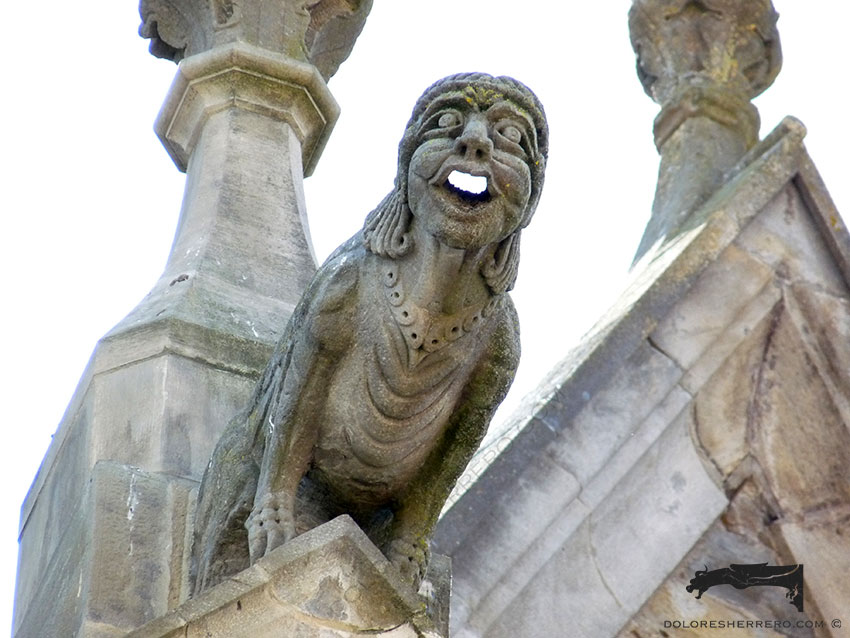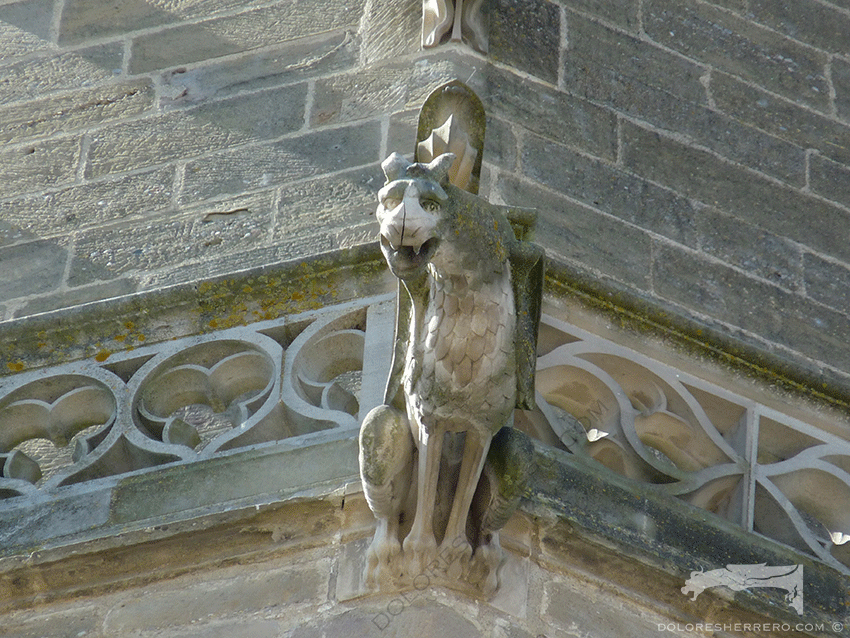In today’s post, we’re going back to France, this time to the mediaeval town of Mirepoix in the region of Occitanie, an enchanting, medieval and magical place for visitors. One of its architectural wonders is the Cathedral of St. Maurice, begun in the late 13th century, restored in the 19th century by Viollet-le-Duc, and unquestionably one of the town’s main attractions. Its gargoyles are quintessential examples for those of us who love these figures.
Gargoyles can occasionally be difficult to classify as they may belong to more than one type. Such is the case of the gargoyles in Mirepoix Cathedral, since practically all of them have a demonic component. Some of the figures are clearly devils, but the others, hybrid animals and anthropomorphs, also present demonic elements.
Generally, the predominant gargoyle figure in religious buildings is the devil. This figure was used to illustrate the dichotomy between the good and sacred (inside the building) and the evil and profane (outside the building), and also reflects the need felt in the Middle Ages to depict evil to the masses. This predominance continued in the Neo-Gothic, bequeathing us some wonderful gargoyles. A good example in Spain can be found in León Cathedral.
In the Middle Ages, the sculptor’s creative freedom found expression in images of the devil. These could take any form, as the artist’s imagination was infinite.
As we saw in an earlier post, some devils are formed from parts of animals. Consequently, devils may often have a quadruped’s body, a bird’s beak and wings and a dog’s or lion’s head. Recall that the bestiaries described both real and fantastic animals as having positive and negative meanings. One of the negative meanings is that of symbolising Satan.
We shall therefore begin by examining the figures of devils. The first two gargoyles that we shall describe are dog-headed devils. One of them has long claws on its feet, human hands reaching back and, as a shocking element against the smooth body, straight fur on the chest that shatters the uniformity of the skin. The other has claws, a beard, large teeth and fangs, and part of the body is covered with scales or dragonish skin.
There are also two devils with a bird’s beak. The first also has pointed ears, a quadruped body, long claws and bat-like wings. The second has a horn on its forehead, bat-like wings and a dragonish neck.
A goat-like devil with a long beard, horns, hoofed forelegs, claws on its rear feet, a prominent windpipe and bat-like wings shows astounding originality.
Another with wings, a dragonish neck and hooves also has huge ears that recall the Panotii (Greek for “all ears”), an extraordinarily grotesque race of people with enormous ears first described in ancient Greek literature. Ctesias of Cnidus (5th century BC) wrote of a race of people dwelling in the mountains of India whose ears cloaked their arms and back. In the Roman world, they were mentioned in works by Megasthenes, Strabo, Pliny, Solinus and Pomponius Mela. In general, they were said to inhabit the continental region of Scythia, and consequently were sometimes called Scythians. They also appear in works by St. Isidore of Seville and Rabanus Maurus.
A third has a quadruped body, dragonish neck, fangs, prominent eyebrows, bat-like wings and a ferocious expression.
An anthropomorph devil, with an animal-like head, beard and protruding eyebrows, holds a stake in its hand. Devils sometimes carry a stick or stake, probably in allusion to the pronged hook that replaced the trident, which was used to hit criminals, something that may have been witnessed by the artists working on artistic representations such as mediaeval final judgements.
Last but not least, there is another gargoyle with a ferocious expression, pointed ears, a dragonish neck and wings.

The first animal monster, a hybrid composed of various animal parts, has prominent eyebrows, wings and rear legs with claws; it does not have forelegs, which seem to be inserted into the body. Another has a lion’s muzzle, fangs, vertical pupils, wings and a body striped with scales.
A quadruped with a prominent windpipe, small wings, fangs and a long tail that looms forwards strikes an aggressive pose. There is also another with fur on its neck that again shatters the smoothness of the body.
In addition, there is a hybrid with the hindquarters of a quadruped, wings, a grotesque animal head and udders. Sometimes, one sees gargoyles depicting animals with udders suckling offspring or, in the case of devils and other monstrous creatures, small beings with an evil meaning. In this case, there is no offspring.
There are also several winged dogs of different shapes and sculptural style.
Lastly, we wish to highlight two gargoyles that could be classified as animal monsters, but which also have a demonic sense and therefore could belong to both types. The first is a winged quadruped with a dragonish neck, and the second is a dog-like animal with somewhat dishevelled fur (demonic element) towards the back.
The anthropomorphs are very unusual. There is one with a human head and large features; its feet are furnished with claws and it has a dragonish body. Another with a winged animal’s body and visible tail is distinct and surprising; it has hair (a fringe) and large features.
The last is fascinating, with a quadruped body and a human head with a mediaeval headdress.
Two of the gargoyles could be classified as fantastical or mythological animals. The first is an animal-human hybrid, with a woman’s head and the body of a bird. This exotic anthropomorph is adorned with a necklace and diadem, and may well represent a harpy, a mythological being that symbolised evil and lust.
The second of the gargoyles resembling a fantastical animal might represent a griffin, a mythological animal that is half eagle and half lion. Representations of the griffin date back to antiquity (e.g. Babylon, Persia, ancient India). It possesses the attributes of the lion (king of the earth) and the eagle (king of the skies). In Christian symbolism, the griffin is one of the best symbols of the dual nature of Christ, with the eagle’s head representing his divinity while the lion’s body represents his humanity. In terms of its negative powers, the griffon often symbolised Satan because of its raptor’s beak and predator’s claws.
- Mirepoix Cathedral (France)
Among the real animals, there are two lions, one with a slightly anthropomorphic face, small pupils and a visible tail, and another with large claws and prominent ribs.
There is also an animal with a simian appearance, holding a forelimb to its chest, a gesture that recalls the frog gargoyle in the Cathedral of Salamanca (Spain).
Also of note is a dog with fur and acanthus-type leaves decorating its body that recalls some of the gargoyles in the Cathedral of Burgos (Spain). It is an impressive gargoyle.
Lastly, there is a wild boar. In Christianity, the wild boar was considered the “evil beast” of the Apocalypse and the antichrist, and it symbolised envy, brutality and lust (the female of the species).
Last but not least, the human figures include a naked man holding his right hand to his throat and wearing a crown. There are other examples of gargoyles depicting humans raising a hand to the throat. This gesture has been described as a sign of the order of journeymen in mediaeval France (signe à l’ordre du compagnon), in which case, the hand would be depicted with the thumb and palm forming a right angle. Another interpretation would be related to a warning about the dangers of misusing everything that travels via the throat (food, drink, words); or to the story of Adam and Eve and the apple, and thus to original sin and the fall. The facial expression is eloquent of suffering.
The gargoyles at Mirepoix are an excellent example of typological and formal variety. Some of them are highly expressive and show great plasticity. If you ever visit Occitanie, make sure to see Mirepoix. In addition to its gargoyles, the city is a delight for visitors. Beauty and magic permeate this pretty town in France.
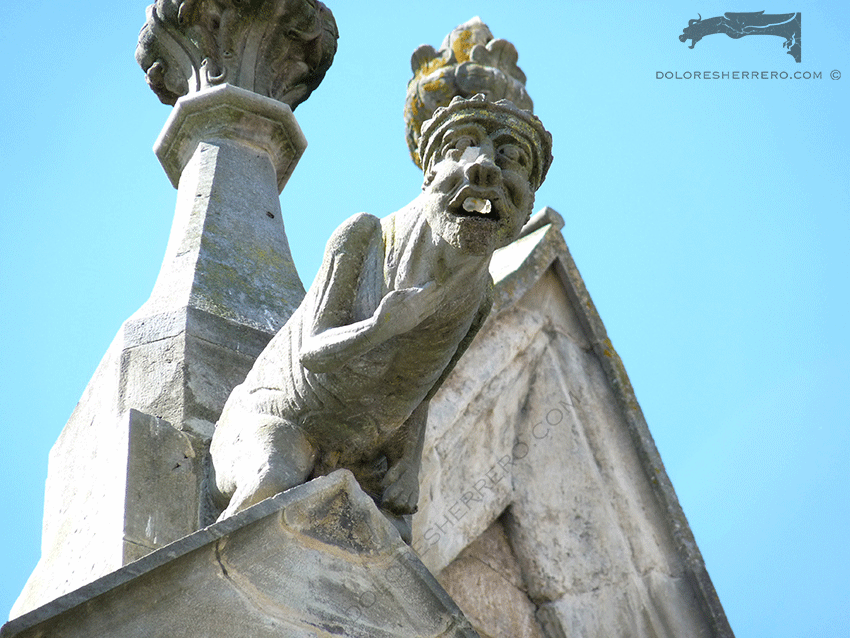
Bibliography consulted
CHARBONNEAU-LASSAY, L., El bestiario de Cristo. El simbolismo animal en la Antigüedad y la Edad Media, Palma de Mallorca, José J. de Olañeta Editor, 1997.
El Fisiólogo. Bestiario Medieval, trad.: M. Ayerra Redín y N. Guglielmi, Buenos Aires, Editorial Universitaria de Buenos Aires, 1971.
KAPPLER, C., Monstruos, demonios y maravillas a fines de la Edad Media, Madrid, Ediciones Akal, S. A., 1986.
LINK, L., El Diablo. Una máscara sin rostro, Madrid, Editorial Síntesis, S. A., 2002.
MARIÑO FERRO, X. R., El simbolismo animal. Creencias y significados en la cultura occidental, Madrid, Ediciones Encuentro, 1996.
REBOLD BENTON, J., Holy Terrors. Gargoyles on medieval buildings, New York, Abbeville Press, 1997.
WARD, L. y STEEDS, W., Demonios. Visión del Diablo en el Arte, Madrid, Edilupa Ediciones, 2007.

Doctor of Art History and researcher specializing in the study of gargoyles.
I am Dolores Herrero Ferrio, and my thesis, “An Approach to the Study of Gargoyles of Gothic Cathedrals in Castilla and León”, is dedicated to the study of these fascinating figures.
If you like gargoyles and art history, you will also enjoy my book, “The Gargoyle and Its Iconography,” a book I have written with great care for those interested in the world of gargoyles.
I have created my own Encyclopedia of Gargoyles, a Gargopedia to share with you, where you will discover all the secrets and wonders of these enigmatic sculptures.
I hope you enjoy this Gargopedia as much as I have enjoyed creating it, and remember that each gargoyle has a story to tell, and here you will discover them all.
 The Gargoyles of Compostela: Guardians and Monsters within its Architecture
The Gargoyles of Compostela: Guardians and Monsters within its Architecture The Enigmatic Gargoyles of the Monterrey Palace in Salamanca
The Enigmatic Gargoyles of the Monterrey Palace in Salamanca The Emblematic Gargoyles of Salamanca’s Casa de las Conchas
The Emblematic Gargoyles of Salamanca’s Casa de las Conchas The Imposing Gargoyles of Valencia’s Lonja: Architectural Splendor and Symbolism
The Imposing Gargoyles of Valencia’s Lonja: Architectural Splendor and Symbolism Imposing Gargoyles at the Head of Palencia Cathedral
Imposing Gargoyles at the Head of Palencia Cathedral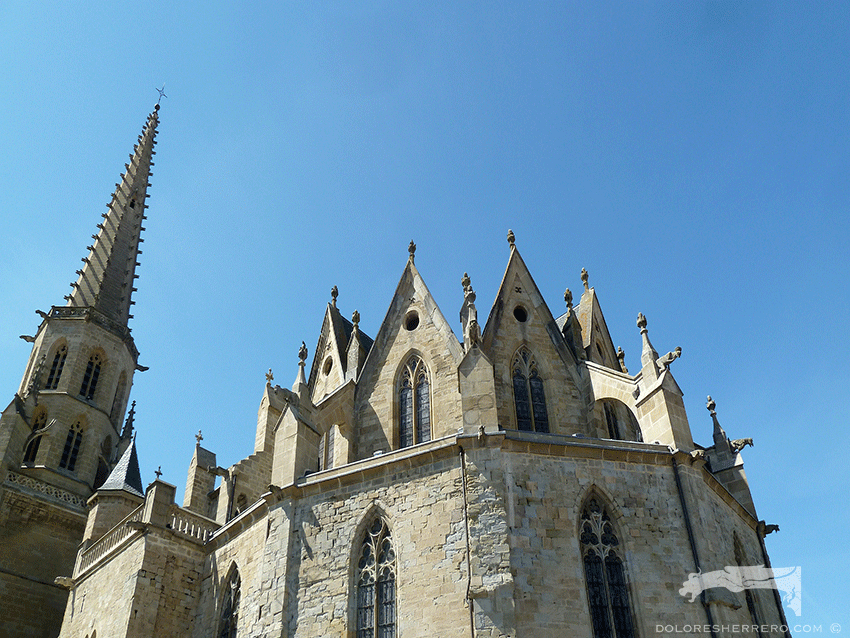
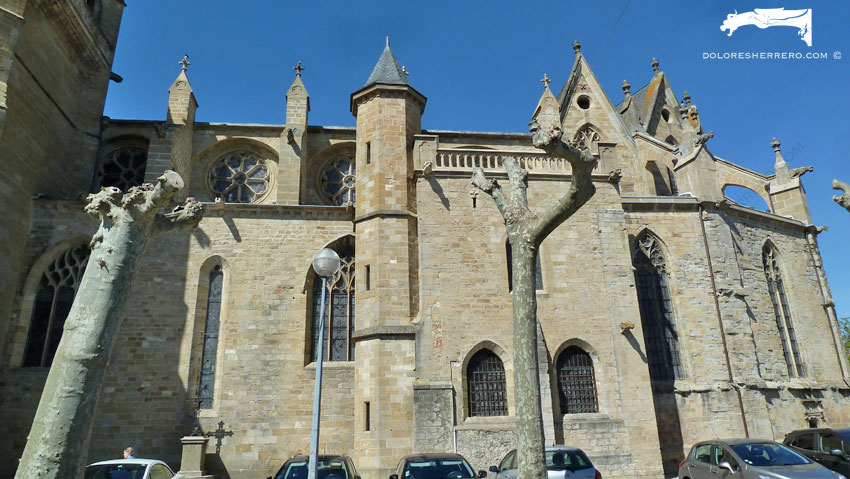




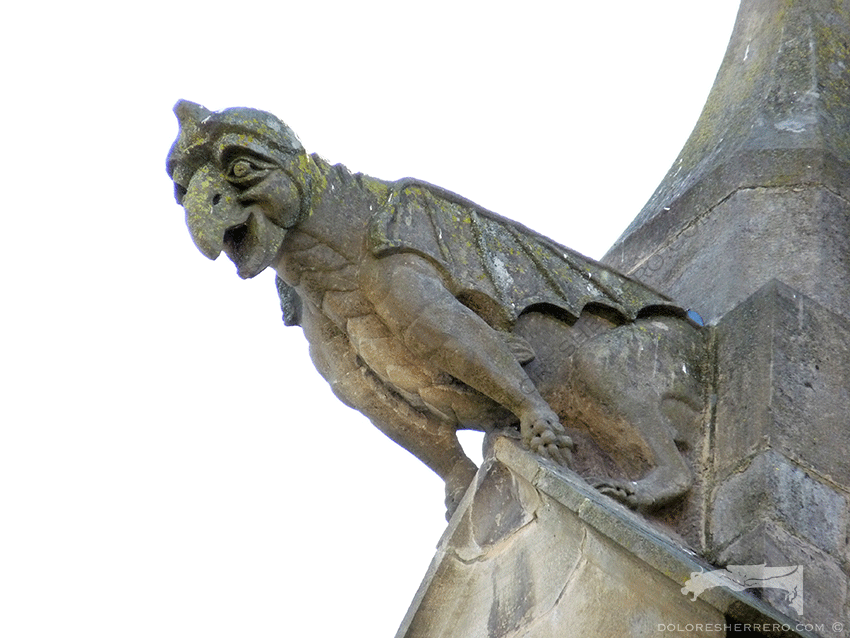

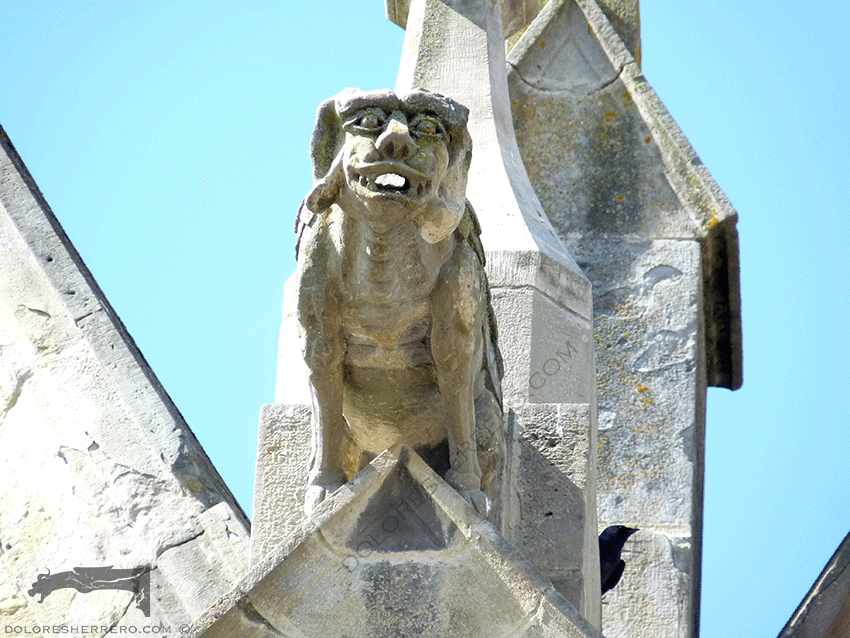




![The Archetypal Gargoyles at Mirepoix Cathedral 15 [AZUL] Gargoyle from St. Maurice Cathedral in Mirepoix (France). It is an animal monster.](https://doloresherrero.com/wp-content/uploads/Gárgola-de-la-Catedral-de-St.gif3_.gif)











